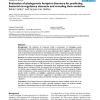324 search results - page 3 / 65 » Detecting common elements of types |
SFP
2001
13 years 8 months ago
2001
: We study type checking that is complete in the sense that it accepts every program whose subexpressions can all be executed without raising a type error at runtime. In a complete...
EUROCAST
2007
Springer
14 years 1 months ago
2007
Springer
After the detection of the first extrasolar planet (exoplanet) more than one decade ago we currently know about more than 200 planets around other stars and there are about twenty...
BMCBI
2011
13 years 2 months ago
2011
Background: Outer membrane proteins (OMPs) are frequently found in the outer membranes of gram-negative bacteria, mitochondria and chloroplasts and have been found to play diverse...
BMCBI
2008
13 years 7 months ago
2008
Background: The detection of conserved motifs in promoters of orthologous genes (phylogenetic footprints) has become a common strategy to predict cis-acting regulatory elements. S...
JAMIA
2011
12 years 10 months ago
2011
Background Systematic study of clinical phenotypes is important for a better understanding of the genetic basis of human diseases and more effective gene-based disease management....


